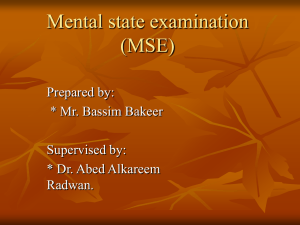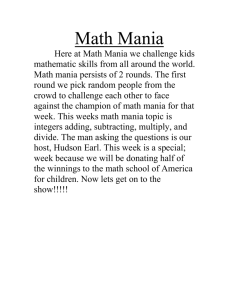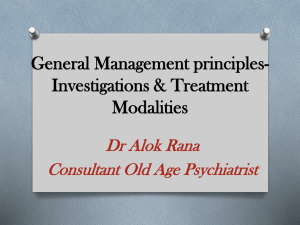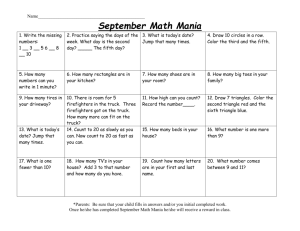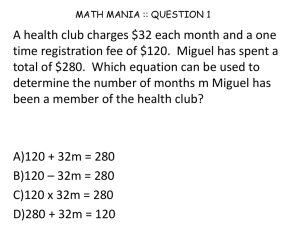MENTAL STATE EXAMINATION (MSE)
advertisement
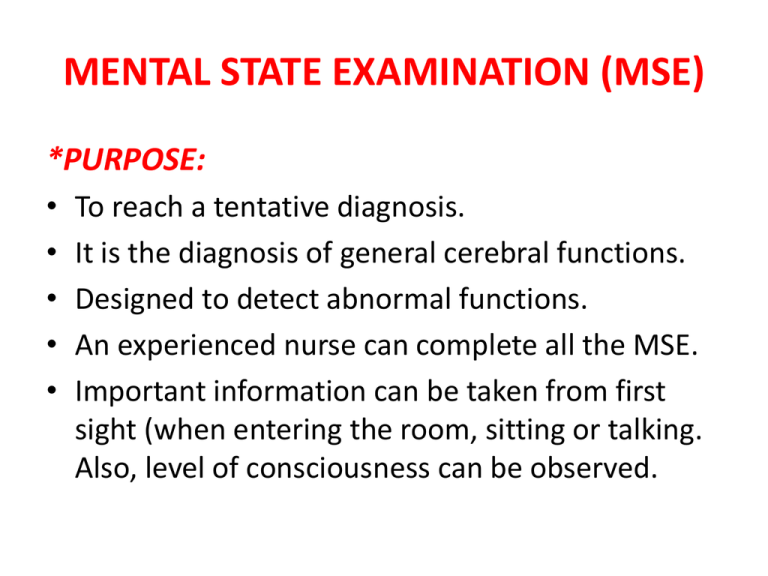
MENTAL STATE EXAMINATION (MSE) *PURPOSE: • • • • • To reach a tentative diagnosis. It is the diagnosis of general cerebral functions. Designed to detect abnormal functions. An experienced nurse can complete all the MSE. Important information can be taken from first sight (when entering the room, sitting or talking. Also, level of consciousness can be observed. 1. GENERAL APPEARANCE: • Good indicator of pts. overall mental functioning. It includes weight, height and general body built. A. Nutritional Status: • Poor nutrition can result from medical or psychiatric disorders. • In anorexia nervosa pt. is emaciated but still thinks she is fat. • Overweight can point to overeating as in affective disorders with hyperphagia. B. Hygiene and dress: • Self care and cleanliness reflects pt.'s awareness and activity level. • In depression: pt. loses interest in his appearance and hygiene. • In mania: pt. dresses in colorful and flamboyant manner. She may use too much makeup and mismatched dress. • In schizophrenia: pt. may use strange items for dress e.g. antennas, bags to protect them from the control of space people. C. Eye contact: • People usually maintain eye contact when they speak & track movement & gestures of interviewer. • Abnormal eye movements can be diagnostic: -Wandering eyes show distractibility, visual hallucinations, mania or organic states. -Avoidance of eye contact may be due to hostility, shyness, or anxiety. -If pt. is suspicious, he tracks your movements and looks to every gesture. 2. PSYCHOMOTOR BEHAVIOR: A. Psychomotor activity: • Reduced in depression & catatonic schizophrenia or increase in mania. B. Posture: • The way pt. sits, walks, and behaves. C. Facial Expression: • Sad face in depression, mask face of Parkinsonism. D. Activity level: • Restlessness in anxiety. • Agitation in some depressed patients. • Excitement in mania. E. Abnormal movements: • Voluntary: such as the mannerisms of the schizophrenia or bizarre movements also seen in schizophrenia. • Involuntary: such as hand tremor in anxiety. 3. MOOD AND AFFECT: A. Mood: • The pervasive and sustained emotion that colors the person's perception of the world. • In depression: pt. sees the world through dark glasses. • In mania: pt. is euphoric or elated, feels superior and able to do great things. • In anxiety: pt. feels afraid of the unknown. Patient is tense and expecting the worst. B. Affect: • External expression of emotional responsiveness. • What is observed in pt.'s facial expression & expressive behavior in response to internal or external stimuli. • Evaluated for its intensity, duration, appropriateness to situation, range of affective expression, and control. • In schizophrenia: blunted (flat), restricted, or inappropriate to situation. • In mania: expansive and out of control. • In hysterical pts.: labile affect that changes from extreme happiness to extreme sadness in minutes. 4. SPEECH: A. Amount of Speech: • Increased in mania and anxiety states were the pt. is talkative. • Pt. with mania may experience a pressure to speak continuously. • Pt. with depression speaks very little and brief. B. Speed: • Anxious pt. speaks rapidly. • Depressed pt. speaks slowly. C. Articulation: • Speech can be slurred (dysarthria) as in organic brain disorders or intoxication with alcohol or hypnotic. D. Rhythm: • In depression speech is monotonous. 5. THOUGHT: A. Thought Process: • The way pt. puts thoughts together and associates between them. • In mania: rapid and pt. feels pressure of thoughts, and may go on to form flight of ideas. • In depression: slow • In schizophrenia: loss of association between thoughts or poverty of thoughts were they could be empty or vague. • Blocking: interruption of process as if they were withdrawn from pt.'s head as in schizophrenia. B. Thought Content: • Delusions: -Fixed false beliefs held by pt. and not shared by persons in his culture. -They indicate that pt. is psychotic e.g. delusions of persecution, reference or grandiosity. • Overvalued ideas: -Unreasonable sustained false beliefs held less firmly than delusions. • Phobias: -Unreasonable fear of exposure to specific objects or situations e.g. agoraphobia, claustrophobia. • Obsessions: -Irresistible recurrent thought or feeling that can not be eliminated by logical effort and associated with anxiety. • Compulsions: -Meaningless acts that pt. feels compelled to perform as counting, washing… • Hypochondria: -Exaggerated concern over one’s health based on false interpretation of physical signs and not supported by realistic pathology. 6. PERCEPTION: • Interpretation of events. • Some types of hallucination appear in some clients according to the senses. • We have to be sure that pt. has no organic problems especially in ? visual hallucination. • Hallucination types: Visual, Auditory, Olfactory, Tactile, and Taste. 7. SENSORIUM AND COGNITION: A. Level of Consciousness: • Pt. awareness of and responsiveness to his internal and external environments. • It can be clouded in organic states and intoxication. • In psychiatric disorders as in dissociative hysteria or fugue states. B. Orientation: • Pt.'s awareness of his time, place and person. • Usually disturbed in organic brain syndromes. C. Concentration: • Ability to keep one’s attention on a certain task. • See if the patient can subtract 7 from 100 and notice his effort and time taken to perform this task. • Impaired in mania were the pt. is distractible by minor stimuli and in anxiety states. D. Memory: • Ability to recall information. • It is divided into: -Immediate: ask pt. to repeat 6 digits in the same order (within seconds to less than a minute). -Short term: tell pt. three items and ask him to repeat them after 5 to 10 minutes. -Long term: ask pt. what he did yesterday. -Remote: ask pt. about information in his childhood, school… E. Abstract thinking: • Ability to deal with concepts. • Ask pt. to explain a known proverb or the similarity between two things. • Answers may be concrete as if the patient says that an orange and apple are both round, • Or abstract if he says that they are both fruit. • Abstract thinking is impaired in schizophrenia and organic brain syndrome. F. Intelligence and information: • If impairment is suspected, ask pt. to perform simple tasks as calculations, • Ask him what remains of a 100 $ if he buys a shirt with 35 $ and a pants with 64 $. • If he finds this difficult, ask easier questions. • Pt.'s fund of information should be relevant to his educational & social background. • Ask about important dates, persons, or… 8. INSIGHT AND JUDGMENT: A. Insight: • Degree of pt.'s awareness that he is ill. • Pt. may deny completely that he has any problem (insight is totally lost). • Some pts. realize that there is a problem but explain it to be the result of somatic or social cause (partial insight). B. Judgment: • Ability to choose appropriate goals and appropriate means to reach them. • Ask pt. what he would do if he smelled smoke in his house or found a closed addressed letter in the street. 9. IMPULSE CONTROL: • Is the patient ability to control his sexual, aggressive and other impulses. • Some patients cannot resist impulses to explore your office; they look in books and turn things e.g. mania. • Impulse control can be assessed from the patient’s history. 10. RELIABILITY: • How reliable is the information gathered about the patient? • Did he/she report his/her condition accurately or was there any difficulty due to mental retardation, dementia or impaired consciousness? • Is there a need for further investigations? 11. SUMMARY: • Major positive and negative data from the history and MSE are summarized. • A provisional diagnosis is suggested and a differential diagnosis is given. • Investigations and tests needed are listed.
